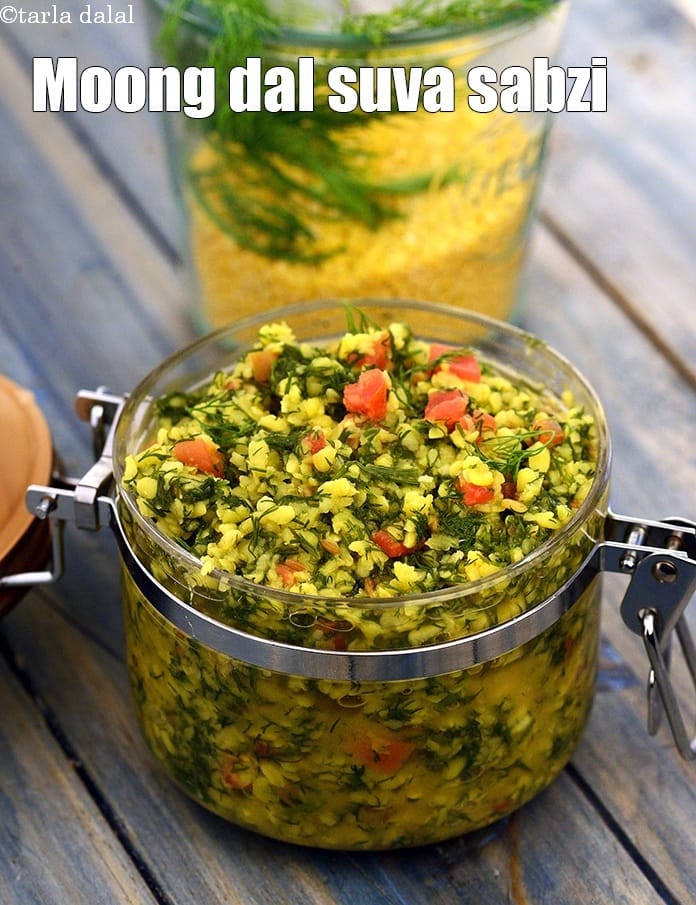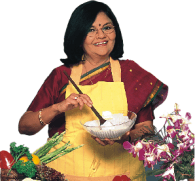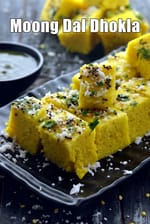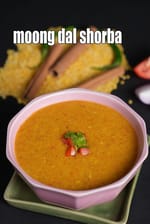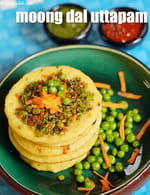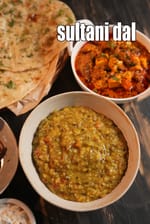moong dal suva sabzi recipe | zero oil sabzi | moong dal tomato shepu sabzi
Table of Content
moong dal suva sabzi is a healthy moong dal sabzi for all. Learn how to make moong dal tomato shepu sabzi.
The unique taste of suva, fortified by moong dal and spiced with green chillies makes this moong dal suva sabzi a must-try.
Suva and tomatoes are rich in vitamin A and iron, while moong dal provides the necessary protein in healthy moong dal suva sabzi.
The order of adding ingredients in moong dal tomato shepu sabzi is very important to ensure that all of them are properly cooked without losing their texture and colour, or becoming mushy.
Relish steaming hot moong dal and suva sabzi with hot phulkas.
Enjoy with moong dal suva sabzi recipe | zero oil sabzi | moong dal tomato shepu sabzi | step by step photos.
Tags
Soaking Time
1 hour
Preparation Time
15 Mins
Cooking Time
13 Mins
Baking Time
0 Mins
Baking Temperature
0
Sprouting Time
0
Total Time
28 Mins
Makes
4 servings
Ingredients
For Moong Dal and Suva Sabzi
- 1 1/2 cups chopped dill leaves
- 1/2 cup yellow moong dal (split yellow gram) , soaked for 1 hour and drained
- 1 tsp cumin seeds (jeera)
- 1 tsp finely chopped green chillies
- 2 tsp finely chopped garlic (lehsun)
- 1/4 tsp turmeric powder (haldi)
- 1/4 tsp chilli powder
- salt to taste
- 1/2 cup chopped tomato
Method
- To make moong dal and suva sabzi, heat a broad non-stick pan on a medium flame and when hot, add the cumin seeds and dry roast on a medium flame for a few seconds.
- Add the green chillies and garlic and dry roast on a medium flame for 30 seconds.
- Add the moong dal and sauté on a medium flame for 1 minute.
- Add the turmeric powder, chilli powder, salt and 1 cup of water and mix well. Cover it with a lid and cook on a medium flame for 3 to 4 minutes, while stirring occasionally.
- Add the dill leaves and mix well. Cover with the lid and cook on a medium flame for another 5 minutes, while stirring occasionally.
- Add the tomatoes and ½ cup of water, mix well and cook on a medium flame for 2 more minutes, while stirring occasionally.
- Serve the moong dal and suva sabzi immediately.
Moong Dal and Suva Sabzi recipe with step by step photos
-
-
like moong dal suva sabzi recipe | zero oil sabzi | moong dal tomato shepu sabzi | then see some other healthy Indian sabzis we love.
- moong dal methi sabzi recipe | healthy methi leaves with moong dal | methi moong dal ki sabzi| with amazing 18 images.
- cabbage foogath recipe | Goan style cabbage foogath | healthy cabbage with coconut sabzi | with 12 amazing images.
- masale wali turai recipe | turai ki sabzi | healthy turai ki bhaji | ridge gourd vegetable | with 23 amazing images.
-
like moong dal suva sabzi recipe | zero oil sabzi | moong dal tomato shepu sabzi | then see some other healthy Indian sabzis we love.
-
- what is moong dal suva sabzi made off?
-
-
This is what yellow moong dal looks like. Yellow moong dal refers to moong beans that have been skinned and split, so that they're flat, yellow, and quick-cooking. They're relatively easy to digest.

-
Put the yellow moong dal in water and wash it. You can see the dirt. This will require you to change the water 2 to 3 times till you get clean water.

-
The moong dal is now clean.

-
Cover and soak the dal in warm water for at least 2 hours.

-
This is what the soaked yellow moong dal looks like.

-
Drain.

-
Keep aside.

-
This is what yellow moong dal looks like. Yellow moong dal refers to moong beans that have been skinned and split, so that they're flat, yellow, and quick-cooking. They're relatively easy to digest.
-
- Yellow moong dal good for Cells & Tissues: Apart from glucose for survival, cells and tissues need protein, calcium and iron for growth and maintenance. Yellow moong dal provides all of these. Just about ¼ cup is enough to provide 12.2 gm of protein, 37.5 mg of calcium and 1.95 mg of iron.
-
Yellow Moong Dal benefits the Heart: The fiber (4.1 g in ¼ cup) present in yellow moong dal prevents the deposition of bad cholesterol (LDL) in the arteries which promotes a healthy heart in turn. A well maintained cholesterol profile will help you prevent complications like stroke. Additionally, it isn’t a good source of fat at all. So you need not worry about that nutrient too. See 7 super benefits of yellow moong dal.

-
- Dill Leaves Exhibit Antioxidant Property: Antioxidants are the substances that help in removing the potentially harmful substances called “free radicals” from our body. They prevent or stop cell damage in your body and thus lowers the risk of chronic diseases like cancer, diabetes and heartdisease. They are also a good way of flushing out toxins from our body. Dill leaves are rich in antioxidants vitamin A and vitamin C. A cup of chopped leaves fulfil 42.5% of day’s vitamin C and 29.9% of day’s vitamin A requirement.
-
Dill Leaves Maintain Bone Health: Osteoporosis is a disease which affects many people as they age. Protein and calcium are the twin pillars to keep the bones healthy. While protein and calcium can be sourced from sprouts, dals, pulses and dairy foods, we also get calcium from cereals like ragi, nuts like almonds and walnuts, seeds like sesame seeds and fruits and vegetables like broccoli, avocado and of course dill leaves too. So don’t forget to add suva bhaji to your list of calcium rich foods. Further to enhance calcium absorption, pair it with a source of vitamin C rich food. See 5 super benefits of suva, dill.

-
-
To make moong dal suva sabzi recipe | zero oil sabzi | moong dal tomato shepu sabzi | heat a broad non-stick pan on a medium flame till hot.

-
Add 1 tsp cumin seeds (jeera).

-
Dry roast on a medium flame for a few seconds.

-
Add 1 tsp finely chopped green chillies.

-
Add 2 tsp finely chopped garlic (lehsun).

-
Dry roast on a medium flame for 30 seconds.

-
Add 1/2 cup soaked and drained yellow moong dal (split yellow gram).

-
Sauté on a medium flame for 1 minute.

-
Add 1/4 tsp turmeric powder (haldi).

-
Add 1/4 tsp chilli powder.

-
Add salt to taste.

-
Add 1 cup of water.

-
Mix well.

-
Cover it with a lid and cook on a medium flame for 3 to 4 minutes, while stirring occasionally.

-
This is how it looks.

-
Add 1 1/2 cups chopped dill leaves.

-
Mix well.

-
Cover with the lid and cook on a medium flame for another 5 minutes, while stirring occasionally.

-
Add 1/2 cup chopped tomatoes.

-
Add ½ cup of water.

-
Mix well.

-
Cook moong dal suva sabzi | zero oil sabzi | moong dal tomato shepu sabzi | on a medium flame for 2 more minutes, while stirring occasionally.

-
Serve moong dal suva sabzi | zero oil sabzi | moong dal tomato shepu sabzi | immediately.

-
To make moong dal suva sabzi recipe | zero oil sabzi | moong dal tomato shepu sabzi | heat a broad non-stick pan on a medium flame till hot.
-
-
moong dal suva sabzi is a perfect sabji to have on a weight loss diet.

-
Have moong dal tomato shepu sabzi with low fat curds or homemade curd as an accomaniment.

-
The net weight of the moong dal suva sabzi is 430 grams.

-
Moong Dal and Suva Sabzi is rich in Folic Acid, Vitamin C, A, B1, Iron, Protein.
- Folic Acid (Vitamin B9): Folic acid is an essential vitamin required throughout pregnancy. Folic acid rich Indian foods (kabuli chana, chana dal, yellow moong dal, urad dal, tooval dal, til ) 16% of RDA.
- Vitamin C : Vitamin C is a great defence against coughs and colds. Have citrus fruits, lemons, vegetables ( capsicum, broccoli, cabbage). 13% of RDA.
- Vitamin A rich recipes, Beta Carotene : Vitamin A is crucial for healthy vision, cell growth and healthy skin. Sources of vitamin A include yellow-orange fruits and vegetables like carrots, mango, papaya, peach, tomatoes, pumpkin etc. and other vegetables like spinach, kale, fenugreek leaves, broccoli, capsicum etc. 13% of RDA.
- Vitamin B1 (Thiamine) : Vitamin B1 protects nerves, helps in carbohydrate metabolism, prevents heart diseases and helps produce red blood cells. 10% of RDA.
- Iron : Iron is essential in the chemical reactions that produce energy from foods. Eat more greens and garden cress seeds to prevent you from being anaemic. Here are the top 7 sources of iron rich foods. 10% of RDA.
- Protein : Protein is required for the managing the wear and tear of all cells of the body. Have protein rich Indian foods like paneer, curd, Greek yoghurt, tofu, almonds, sprouts, chana, rajma, chick peas, quinoa, buckwheat ). 9% of RDA.

-
moong dal suva sabzi is a perfect sabji to have on a weight loss diet.
Nutrient values (Abbrv)per plate
| Energy | 73 cal |
| Protein | 5.1 g |
| Carbohydrates | 12.5 g |
| Fiber | 2 g |
| Fat | 0.3 g |
| Cholesterol | 0 mg |
| Sodium | 7.7 mg |
Click here to view Calories for Moong Dal and Suva Sabzi
The Nutrient info is complete
Mruga D
July 20, 2020, 4:15 p.m.
Suva and Moong dal, both are loaded with iron...I make this recipe quite often to improve my haemoglobin levels...goes really well with brown rice...
Foodie #559116
Aug. 6, 2019, 2:06 p.m.
Very nice
Hitesh
Aug. 21, 2018, 3:44 p.m.
I was a wee bit sceptical about cooking without oil/ghee. I was amazed at how it turned out, tasty, not mushy & even my wife complimented on the final product. Simple.
Tarla Dalal
Aug. 21, 2018, 3:44 p.m.
Congrats Hitesh and thanks for the feedback.
Foodie #646508
Aug. 25, 2016, 9:38 a.m.
